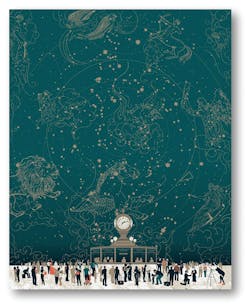Painting and poetry, video and performance, interactive media and sculpture, all are represented in a new exhibition of contemporary art commissioned in honor of the centennial of Grand Central Terminal. On Time/Grand Central at 100 was curated and organized by MTA Arts for Transit and Urban Design and is on view at the New York Transit Museum Gallery at Grand Central from March 6 through July 7.
Artists interpret the theme of time and the people who move and live through it, who are connected to the past and future through their experience in this iconic, romantic place.
“Our clocks keep track, ticking past seconds, minutes, hours, days. In Grand Central, the clock stands sentinel, measuring moments and bearing witness to the millions who pass through as we bustle to and from our family, our work, our passions, our lives,” said Amy Hausmann, assistant director, MTA Arts for Transit, in describing the inspiration for the exhibit. “It is a place where past, present and future come together. The artists are thinking about a sense of time, bending it and exploring what this mythic, iconic place means to us.”
“The city orbits around eight million/ centers of the universe” begins the poem “Grand Central” by former U.S. Poet Laureate Billy Collins, which was commissioned by Arts for Transit and the Poetry Society of America for the Poetry in Motion program in honor of the Centennial. Collins succinctly captures the communal sense of place felt by all who travel through the terminal.
Traces of journeys are the focus of works by artist Jim Campbell, who considers incremental time by measuring footsteps, using video-based LEDs to stagger time and create shadows of motion that sweep across the terminal floor. Paul Himmel, a noted mid-century fashion photographer for Vogue and Harper’s Bazaar, pins down the timelessness of the solitary figure in his poetic black and white images that isolate a single figure, standing stock-still in the blur of a crowd.
Tracking time by the sun’s rays is the focus of Penelope Umbrico’s work as she amasses variations of one of the most recognizable images of the terminal — light streaming through the windows and pooling on the main concourse floor — creating a wholly new composition that prompts the viewer to take a closer look at how photography, memory and image making are joined and indexed.
Vik Muniz takes a culturally iconic image, "Rolling Power" by Charles Sheeler featuring engine parts from the Henry Dreyfuss-designed New York Central locomotive, and transforms it through his own meticulous method of hand-crafted paper collage and photography, an apt homage to the house that built the New York Central Railroad and utilized newly-created time zones to dispatch trains across the country, on time.
Lothar Osterburg brings a fantastical version of Grand Central to life, blurring the lines between past and present with his inky images of the famous grand vaulted space. Osterburg intuitively rebuilds scenes from memory that capture his imagination, in this case — Grand Central’s main concourse complete with staircases, steam engines and zeppelins. The small-scale models, built from bits of found and re-purposed materials, are photographed using the 19th century method of copperplate photogravure, a painstakingly labor-intensive printing process that results in a beguiling image of a mysterious, yet eerily familiar place.
Graphic designers and illustrators were challenged to capture the iconic shapes, places and moments within Grand Central. Marcos Chin and Pop Chart Lab embrace the decorative elements of the historic building — the clocks, ornamentation, constellations — and infuse it with color and scale uniquely their own. Chin creates a parade of fashion where architecture becomes attire while Pop Chart Lab diagrams the constellations of the famous sky ceiling arching down to meet the travelers, strangers and lovers who always surround the famed clock. That same clock is the implied protagonist in Sophie Blackall’s illustration inspired by a recent romantic “Missed Connection” on Craigslist that takes place under the stars on the main concourse.
Painter Olive Ayhens hones in on the architectural details from above to create a swirling, bold tapestry of color that conveys the reflection of life both inside and outside the terminal. She uses the constellations as the sky above the terminal, freeing them from their earthly architecture.
Video, performance and interactive media are represented in the exhibit. Alexander Chen creates a unique real-time mapping system that illustrates arriving subway and commuter trains into the terminal, so that the frequent arrival of hundreds of commuters creates a syncopated rhythm for the digital age. London Squared aims a quirky set of eyes on the everyday at Grand Central, animating and transforming the mundane in a short film that adds a comic take on routine social exchanges. Improv Everywhere, stops time dead in its tracks with their famous frozen-in-time Grand Central YouTube video and then completes the circle with a new work which brought a lively, unexpected flashlight performance into Grand Central’s monumental catwalk windows, on its birthday.
Composer Ian Dicke presents "Grand Stage," one of four movements featured in a work commissioned by the San Francisco Conservatory of Music, with video projections, as a celebration of time and movement. The project will debut in San Francisco on March 2, and the third movement, a deconstruction of Harry Burr’s chart-topping popular song from 1913, “Last Night Was the End of the World,” is included in the exhibition.
Objects that were lost are found again in Jane Greengold’s installation, which uses 100 years of memorabilia and talismanic items to evoke the experience of travelers to and from Grand Central over its long history. Greengold creates a fictional narrative, weaving together objects she imagines were never claimed at the terminal’s epic Lost and Found. Patrick Jacobs creates a unique microscopic view into the terminal’s workings. Observers peer through a fisheye lens at a miniature installation depicting the grand views from the windows on the main concourse. Walter Martin and Paloma Muñoz create photographic images of magical snow globes, depicting commuters muddling through their own life journeys.
Illustrator Peter Sís reaches back to his memory of an editor and mentor, Jacqueline Kennedy Onassis, who guided him through the long-ago process of book-making, imagining that she continues to serve as an angel guardian of this historic terminal, one that survives because of her efforts to save it from destruction.
“Collectively, our goal is to share the work of very interesting artists who each have a different way of considering time, which is an ever present concern for all who have passed through Grand Central in the past and who will visit this grand space in the future,” said Arts for Transit Director Sandra Bloodworth.
Related cultural events are programmed during this free exhibition including:
Grand Central’s Vanderbilt Hall from March 25 to March 31, HEARD•NY, a major project by Chicago-based artist Nick Cave, co-presented with Creative Time, that will transform Grand Central with 30 life-size, multi-colored horses, peacefully “grazing” and periodically breaking into choreographed movement to the accompaniment of live music.
At 7 p.m. April 10, in Vanderbilt Hall, Arts for Transit and the Poetry Society of America present Keeping Time/ Poets and Musicians Honor Grand Central featuring Billy Collins, Aracelis Girmay, Jeffrey Yang and others.

